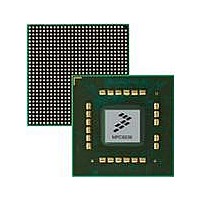MPC8536DS Freescale Semiconductor, MPC8536DS Datasheet - Page 1460

MPC8536DS
Manufacturer Part Number
MPC8536DS
Description
BOARD DEV SYSTEM MPC8536E
Manufacturer
Freescale Semiconductor
Series
PowerQUICC III™r
Type
MPUr
Datasheets
1.MPC8536EBVTAVLA.pdf
(127 pages)
2.MPC8536EBVTAVLA.pdf
(1706 pages)
3.MPC8536DS.pdf
(2 pages)
4.MPC8536DS.pdf
(126 pages)
Specifications of MPC8536DS
Contents
Board, Software and Documentation
Processor Series
MPC85xx
Core
e500
Data Bus Width
32 bit
Maximum Clock Frequency
667 MHz
Operating Supply Voltage
- 0.3 V to + 1.21 V
Maximum Operating Temperature
+ 105 C
Data Ram Size
32 KB
Interface Type
SPI, USB
Program Memory Type
DDR2, DDR3, SDRAM
Core Size
32 Bit
Program Memory Size
544KB
Cpu Speed
1.5GHz
Digital Ic Case Style
BGA
No. Of Pins
783
Supply Voltage Range
0.95V To 1.05V
Rohs Compliant
Yes
For Use With/related Products
MPC8536
Lead Free Status / RoHS Status
Lead free / RoHS Compliant
- MPC8536EBVTAVLA PDF datasheet
- MPC8536EBVTAVLA PDF datasheet #2
- MPC8536DS PDF datasheet #3
- MPC8536DS PDF datasheet #4
- Current page: 1460 of 1706
- Download datasheet (15Mb)
Universal Serial Bus Interfaces
21.8.2.2
21.8.2.2.1
In order to conserve power, USB controller automatically enters the suspended state when no bus traffic
has been observed for a specified period. When suspended, the USB controller maintains any internal
status, including its address and configuration. Attached devices must be prepared to suspend at any time
they are powered, regardless of if they have been assigned a non-default address, are configured, or neither.
Bus activity may cease due to the host entering a suspend mode of its own. In addition, a USB device shall
also enter the suspended state when the hub port it is attached to is disabled.
The USB controller exits suspend mode when there is bus activity. It may also request the host to exit
suspend mode or selective suspend by using electrical signaling to indicate remote wake-up. The ability
of a device to signal remote wake-up is optional. The USB controller is capable of remote wake-up
signaling. When the USB controller is reset, remote wake-up signaling must be disabled.
21.8.2.2.2
The USB controller moves into the suspend state when suspend signaling is detected or activity is missing
on the upstream port for more than a specific period. After the device controller enters the suspend state,
the DCD is notified by an interrupt (assuming DC Suspend Interrupt is enabled). When the USBSTS[SLI]
(device controller suspend) is set, the device controller is suspended.
DCD response when the device controller is suspended is application specific and may involve switching
to low power operation.
Information on the bus power limits in suspend state can be found in USB 2.0 specification.
21.8.2.2.3
If the USB controller is suspended, its operation is resumed when any non-idle signaling is received on its
upstream facing port. In addition, the USB controller can signal the system to resume operation by forcing
resume signaling to the upstream port. Resume signaling is sent upstream by writing a '1' to the
PORTSC[FPR] (resume bit) while the device is in suspend state. Sending resume signal to an upstream
port should cause the host to issue resume signaling and bring the suspended bus segment (one more
devices) back to the active condition.
21.8.3
The USB 2.0 specification defines an endpoint, also called a device endpoint or an address endpoint as a
uniquely addressable portion of a USB device that can source or sink data in a communications channel
between the host and the device. The endpoint address is specified by the combination of the endpoint
number and the endpoint direction.
21-126
Managing Endpoints
Suspend/Resume
Suspend Description
Suspend Operational Model
Resume
Before resume signaling can be used, the host must enable it by using the
Set Feature command defined in device framework (Chapter 9) of the USB
2.0 Specification.
MPC8536E PowerQUICC III Integrated Processor Reference Manual, Rev. 1
NOTE
Freescale Semiconductor
Related parts for MPC8536DS
Image
Part Number
Description
Manufacturer
Datasheet
Request
R
Part Number:
Description:
Manufacturer:
Freescale Semiconductor, Inc
Datasheet:
Part Number:
Description:
Manufacturer:
Freescale Semiconductor, Inc
Datasheet:
Part Number:
Description:
Manufacturer:
Freescale Semiconductor, Inc
Datasheet:
Part Number:
Description:
Manufacturer:
Freescale Semiconductor, Inc
Datasheet:
Part Number:
Description:
Manufacturer:
Freescale Semiconductor, Inc
Datasheet:
Part Number:
Description:
Manufacturer:
Freescale Semiconductor, Inc
Datasheet:
Part Number:
Description:
Manufacturer:
Freescale Semiconductor, Inc
Datasheet:
Part Number:
Description:
Manufacturer:
Freescale Semiconductor, Inc
Datasheet:
Part Number:
Description:
Manufacturer:
Freescale Semiconductor, Inc
Datasheet:
Part Number:
Description:
Manufacturer:
Freescale Semiconductor, Inc
Datasheet:
Part Number:
Description:
Manufacturer:
Freescale Semiconductor, Inc
Datasheet:
Part Number:
Description:
Manufacturer:
Freescale Semiconductor, Inc
Datasheet:
Part Number:
Description:
Manufacturer:
Freescale Semiconductor, Inc
Datasheet:
Part Number:
Description:
Manufacturer:
Freescale Semiconductor, Inc
Datasheet:
Part Number:
Description:
Manufacturer:
Freescale Semiconductor, Inc
Datasheet:










